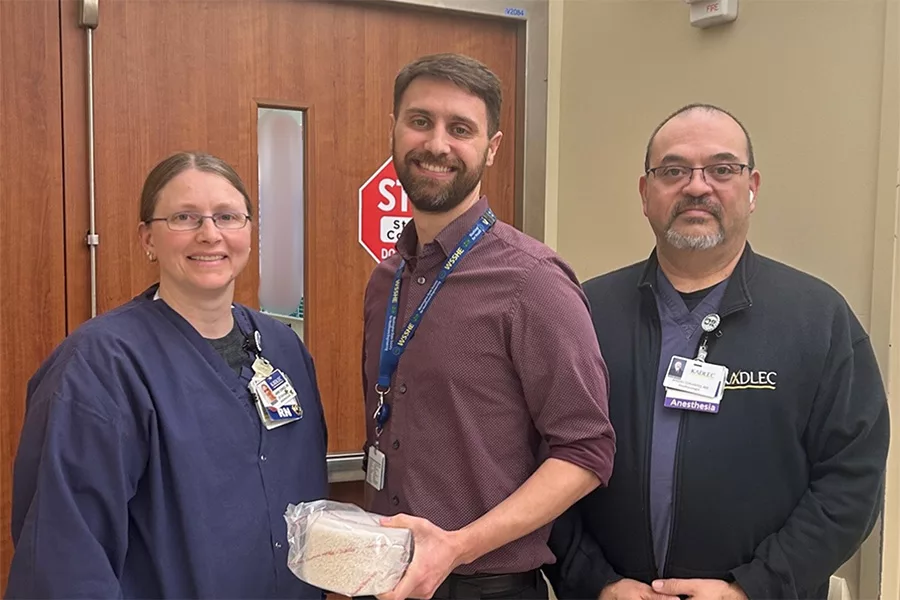
Home » Kadlec clears the air with new ventilator scrubbing compound
Kadlec clears the air with new ventilator scrubbing compound

From left, Anne Eerkes, Kadlec’s operating room and endoscopy manager, plant operations manager Jacob Raleigh, and Dr. Miguel Cervantes, medical director of anesthesia services, hold one of the canisters containing a new and less toxic compound used in the hospital’s ventilators to scrub carbon dioxide from the exhaled breath of patients.
Courtesy Kadlec Regional Medical CenterMarch 13, 2025
Until recently, Kadlec Regional Medical Center paid nearly $4,000 per month as part of its efforts to keep patients breathing during surgery.
Like many hospitals, Kadlec previously used soda lime products to scrub carbon dioxide exhaled by patients on ventilators while under general anesthesia. In Washington state, those products are considered hazardous waste, requiring all the requisite oversight as well as higher disposal costs to send it to special landfills.
Now, with the support of state ecology officials, Kadlec has shifted to a new medium to use in its ventilators and similar respiratory therapy equipment that is just as effective and safer to handle. It also will net the hospital about $20,000 per year in cost savings.
Hospital officials say they are always happy to reduce expenses but they see the biggest win being the environmental benefit.
“It really showcases our team’s dedication to a vision for health for a better world,” Jake Raleigh, Kadlec’s facilities manager, told the Tri-Cities Area Journal of Business.
Used soda lime was by far the largest portion of the hospital’s hazardous waste, enough to designate it a medium-quantity generator. That designation meant Kadlec was producing more than 2,640 pounds of hazardous waste per year.
“It’s the level of carbon dioxide in it,” Raleigh said. “It can be hazardous if it enters groundwater.”
The state Department of Ecology requires any Washington business identified as a medium- or high-quantity generator to submit annual pollution prevention plans. That has led ecology officials to suggest potential alternatives.
“There are safer alternatives out there, and we can help businesses research options,” said Maryflor Garcia, a state toxic reductions specialist, in a release.
But past recommendations haven’t been feasible for a variety of reasons.
“It does change processes,” Raleigh said, noting that switching out soda lime for another product couldn’t be made unilaterally. “A lot of collaboration (with hospital staff) is needed.”
Eventually, the hospital’s self-described “green team” found an alternative product that would work with Kadlec’s respiratory therapy equipment and be integrated into its general anesthesia processes while also reducing its hazardous waste output.
Even though the new product costs twice as much upfront, the savings in disposal costs still make it a net positive on the budget.
Raleigh said the new product is essentially the same with “just a change in the chemical composition.” It also changes color from white to purple as its air scrubbing capacity is exhausted.
The switch to a soda lime alternative is just the latest example of the work done by Kadlec’s green team, Raleigh said. The hospital is way ahead of schedule to meet the state’s new clean energy requirements because of the team’s efforts. Its work to eliminate the hospital’s piped nitrous oxide, also used in general anesthesia, in exchange for canisters has also brought a huge benefit.
“We’re constantly doing thing as part of our environmental stewardship,” said hospital spokeswoman Emily Volland.
Latest News Local News Environment Health Care Science & Technology
KEYWORDS March 2025
Related Articles
Related Products





